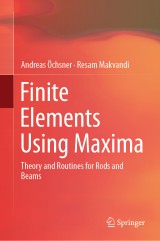Details

Finite Elements Using Maxima
Theory and Routines for Rods and Beams|
85,59 € |
|
| Verlag: | Springer |
| Format: | |
| Veröffentl.: | 21.05.2019 |
| ISBN/EAN: | 9783030171995 |
| Sprache: | englisch |
Dieses eBook enthält ein Wasserzeichen.
Beschreibungen
<div>This book provides a study aid on the finite element method. Based on the free computer algebra system “Maxima”, it presents routines to symbolically or numerically solve problems in the context of plane truss and frame structures. This allows readers to not only check classical “hand calculations” but also understand the computer implementation of the method. The mechanical theories focus on the classical one-dimensional structural elements, i.e. bars, Euler–Bernoulli and Timoshenko beams as well as their combination to generalized beam elements. Focusing on one-dimensional elements reduces the complexity of the mathematical framework and the resulting matrix equations can still be displayed with all components, and not only in a symbolic representation. The use of a computer algebra system and the incorporated functions, e.g. for equation solving, highlights the methodology of the finite element method rather than standard procedures.</div><div><br></div><div>The book is based on the Springer Brief “Finite Elements for Truss and Frame Structures” (978-3-319-94940-6) by the same authors.</div><div><br></div>
<p>Introduction.- Maxima - A Computer Algebra System.- Rods and Trusses.- Euler-Bernoulli Beams and Frames.- Timoshenko Beams and Frames.</p>
<div>Andreas Öchsner is a Full Professor of Lightweight Design and Structural Simulation at Esslingen University of Applied Sciences, Germany. After completing his Dipl.-Ing. degree in Aeronautical Engineering at the University of Stuttgart (1997), he served as a research and teaching assistant at the University of Erlangen-Nuremberg from 1997 to 2003 while pursuing his Doctor of Engineering Sciences (Dr.-Ing.) degree. From 2003 to 2006, he was an Assistant Professor at the Department of Mechanical Engineering and Head of the Cellular Metals Group affiliated with the University of Aveiro, Portugal. He spent seven years (2007–2013) as a Full Professor at the Department of Applied Mechanics, Technical University of Malaysia, where he was also Head of the Advanced Materials and Structure Lab. From 2014 to 2017 he was a Full Professor at the School of Engineering, Griffith University, Australia and Leader of the Mechanical Engineering Program (Head of Discipline and Program Director). </div><div><br></div><div>Resam Makvandi is a Ph.D. candidate and research fellow at the Institute of Mechanics, Otto von Guericke University of Magdeburg, Germany. He completed his B.Sc. degree at the Islamic Azad University, Ahvaz Branch, Iran (2010) and his M.Eng. degree at the University of Technology, Malaysia (2013), both in Mechanical Engineering.</div><div><br></div>
<div>This book provides a study aid on the finite element method. Based on the free computer algebra system “Maxima”, it presents routines to symbolically or numerically solve problems in the context of plane truss and frame structures. This allows readers to not only check classical “hand calculations” but also understand the computer implementation of the method. The mechanical theories focus on the classical one-dimensional structural elements, i.e. bars, Euler–Bernoulli and Timoshenko beams as well as their combination to generalized beam elements. Focusing on one-dimensional elements reduces the complexity of the mathematical framework and the resulting matrix equations can still be displayed with all components, and not only in a symbolic representation. The use of a computer algebra system and the incorporated functions, e.g. for equation solving, highlights the methodology of the finite element method rather than standard procedures.</div><div><br></div><div>The book is based on the Springer Brief “Finite Elements for Truss and Frame Structures” (978-3-319-94940-6) by the same authors.</div><div><br></div>
<p>Offers a study aid on the FEM, based on the free computer algebra system “Maxima”</p><p>Allows readers to check classical “hand calculations” and to understand the computer implementation</p><p>Demonstrates the classical Euler–Bernoulli and Timoshenko beams as well as their combination</p>
Diese Produkte könnten Sie auch interessieren:

Neutron Applications in Earth, Energy and Environmental Sciences

von: Liyuan Liang, Romano Rinaldi, Helmut Schober

149,79 €

Nanobioelectronics - for Electronics, Biology, and Medicine

von: Andreas Offenhäusser, Ross Rinaldi

96,29 €














